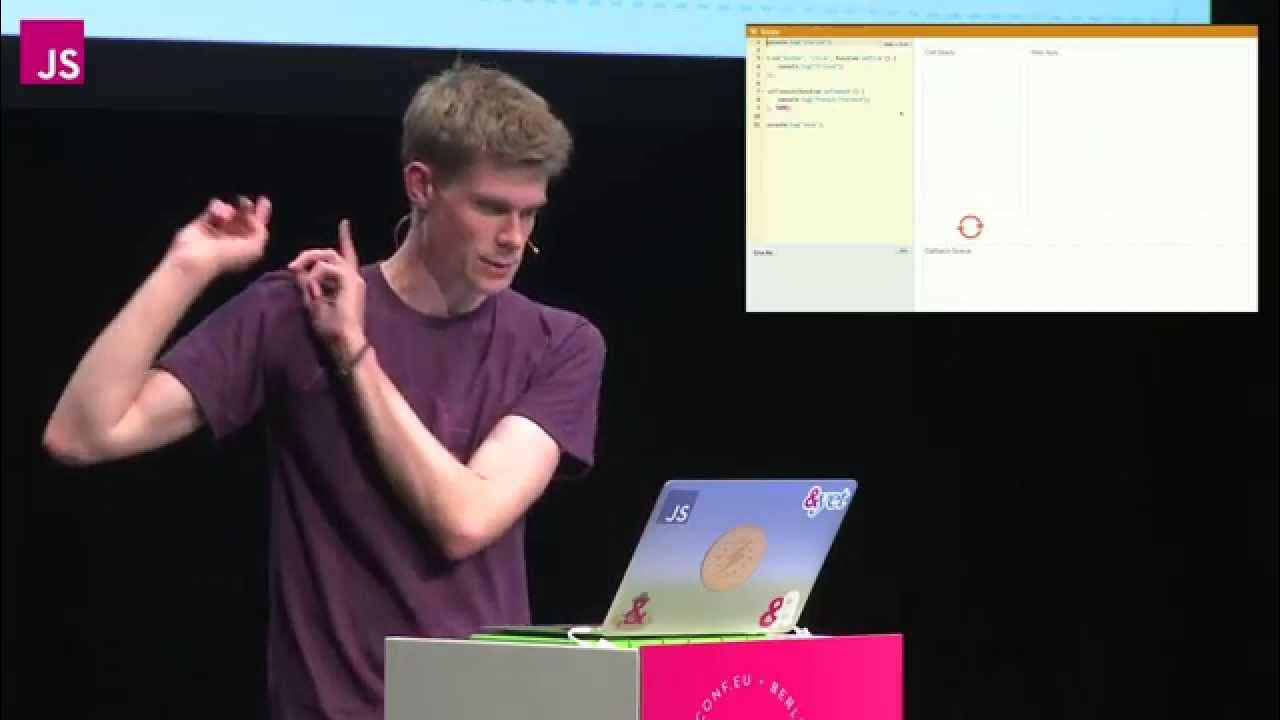What exactly is the Event Loop in JavaScript? | CodeSketched
Summary
TLDRThis video explains the concept of the event loop in JavaScript, helping viewers understand its role in executing code, processing events, and handling queued tasks. It covers key concepts such as the stack, heap, and message queue, showing how functions are managed during execution. The video also explains 'run to completion' and demonstrates how the event loop processes messages in the queue. Additionally, it clarifies how events, like button clicks or setTimeout, trigger functions to be added to the queue for later execution, contributing to the seamless event-driven experience in JavaScript.
Takeaways
- 😀 The event loop in JavaScript is a runtime model responsible for executing code, processing events, and executing queued sub-tasks.
- 😀 The event loop is based on three main concepts: the stack, the heap, and the queue.
- 😀 The stack is used to track function execution, with each function call forming a stack frame that holds references to local variables.
- 😀 The heap is an unstructured region of memory where objects are allocated, with references to objects stored on the stack.
- 😀 The queue is a message queue that holds messages to be processed, where each message has an associated function to handle it.
- 😀 The event loop processes messages in the queue, starting with the oldest, and executes the associated function.
- 😀 JavaScript functions follow the 'run to completion' model, meaning a function executes fully before another function is processed.
- 😀 If long-running synchronous code executes on the main thread, it can cause the browser to hang and show a dialog that a script is taking too long.
- 😀 The event loop synchronously waits for a message to be added to the message queue and processes it once available.
- 😀 Events, such as button clicks or `setTimeout`, add messages to the message queue, where they wait for the event loop to process them.
- 😀 The `setTimeout` function adds a message to the queue with a specified delay, but the function still waits for other messages in the queue to execute, even with a 0-second delay.
Q & A
What is the event loop in JavaScript?
-The event loop is a runtime model in JavaScript responsible for executing code, processing events, and executing queued sub-tasks. It helps manage how JavaScript code is executed, especially in an asynchronous environment.
Why is it called an event loop?
-It's called an event loop because it continuously waits for events to be added to the message queue. Once an event is detected, it processes the corresponding handler, looping through this process as long as events keep coming in.
What are the three main concepts the event loop depends on?
-The event loop relies on three main concepts: the stack, the heap, and the queue. These components are crucial in understanding how JavaScript manages function execution and memory allocation.
How does the function call stack work in JavaScript?
-Every function call in JavaScript adds a frame to the function call stack. When a function is executed, its local variables and references are stored in the stack frame. Once the function finishes execution, the frame is removed from the stack.
What is the heap in JavaScript?
-The heap is an unstructured region of memory where objects are allocated. While references to objects are stored on the stack, the actual objects reside in the heap, allowing for dynamic memory allocation.
What role does the message queue play in the event loop?
-The message queue holds messages (events) to be processed. Each message has an associated function handler. The event loop processes these messages by pulling them from the queue and executing the corresponding function.
What does 'run to completion' mean in JavaScript's event loop?
-'Run to completion' means that once a function starts executing, it runs to the end without interruption. No other function can preemptively run until the current function finishes, ensuring a predictable execution order.
How does the event loop handle multiple messages in the queue?
-When multiple messages are in the queue, the event loop processes them one by one, starting with the oldest message. The associated function is executed, and any new function calls made during execution are pushed onto the function call stack.
How are messages added to the message queue?
-Messages are added to the message queue when an event occurs that has a corresponding event handler attached. For example, if a button is clicked and an 'onclick' listener is present, the message is added to the queue.
What happens when 'setTimeout' is used in JavaScript?
-The 'setTimeout' function adds a message to the message queue after a specified delay. The function passed to 'setTimeout' will be executed once its timeout period elapses, but it will wait for any earlier messages in the queue to be processed first.
Outlines

Этот раздел доступен только подписчикам платных тарифов. Пожалуйста, перейдите на платный тариф для доступа.
Перейти на платный тарифMindmap

Этот раздел доступен только подписчикам платных тарифов. Пожалуйста, перейдите на платный тариф для доступа.
Перейти на платный тарифKeywords

Этот раздел доступен только подписчикам платных тарифов. Пожалуйста, перейдите на платный тариф для доступа.
Перейти на платный тарифHighlights

Этот раздел доступен только подписчикам платных тарифов. Пожалуйста, перейдите на платный тариф для доступа.
Перейти на платный тарифTranscripts

Этот раздел доступен только подписчикам платных тарифов. Пожалуйста, перейдите на платный тариф для доступа.
Перейти на платный тариф5.0 / 5 (0 votes)






